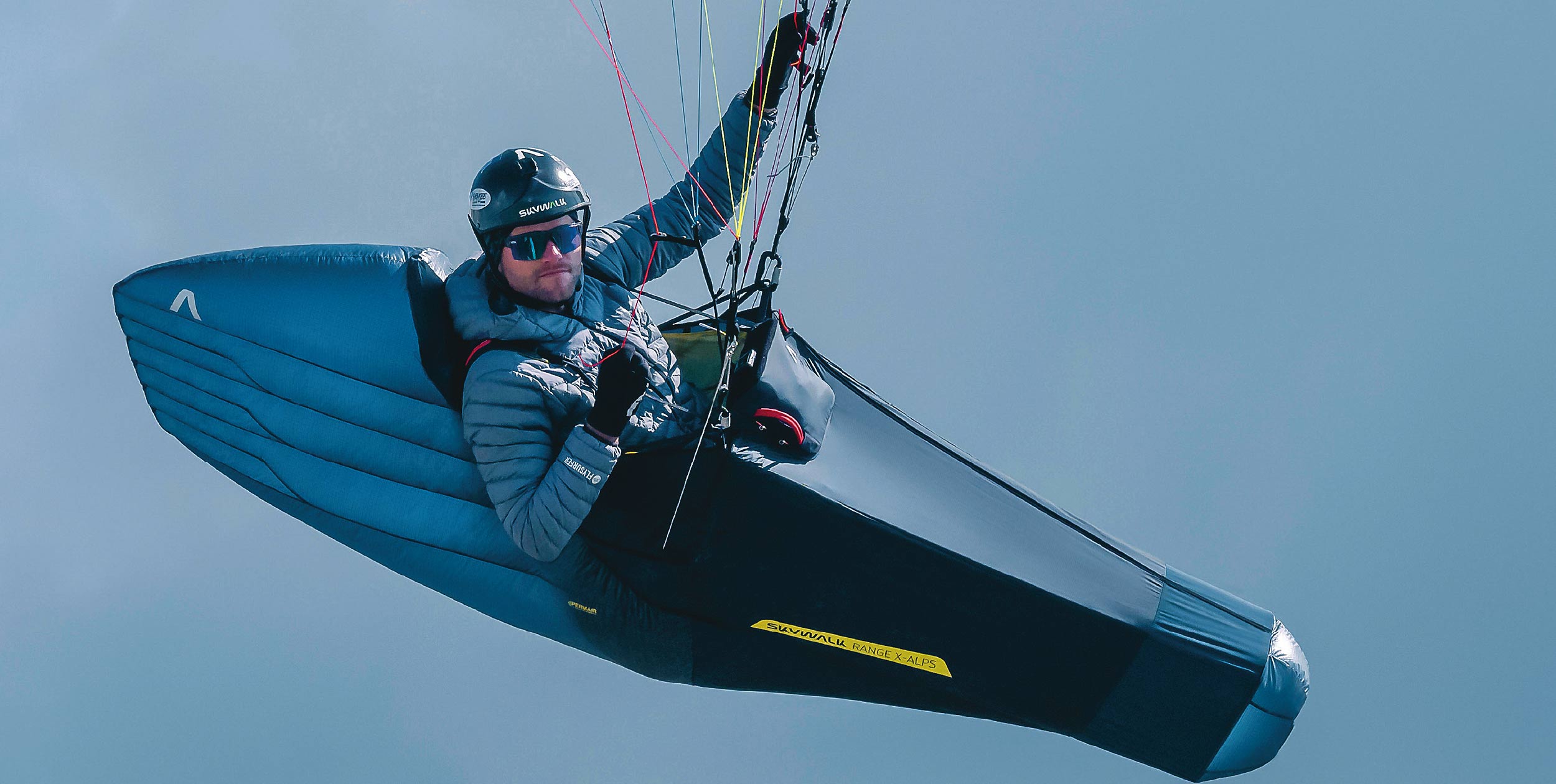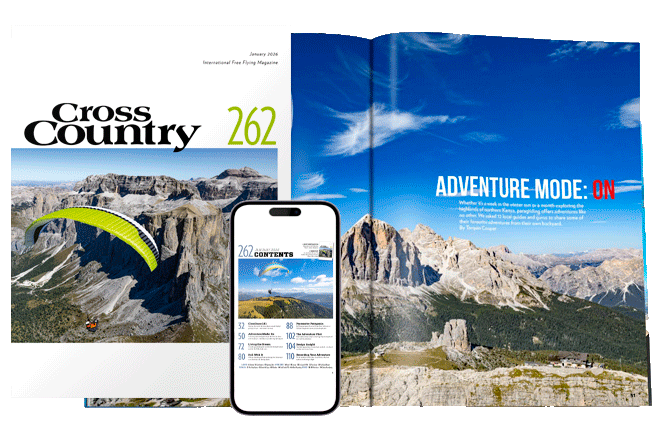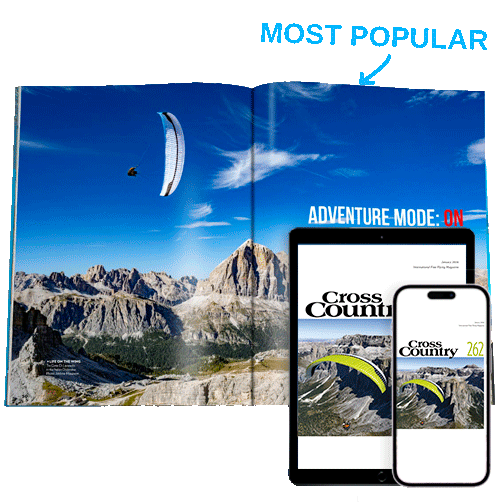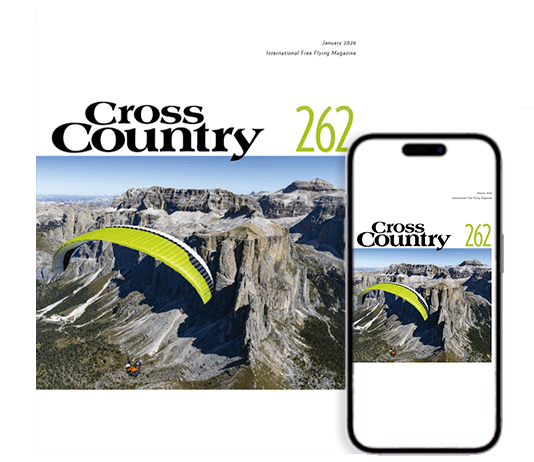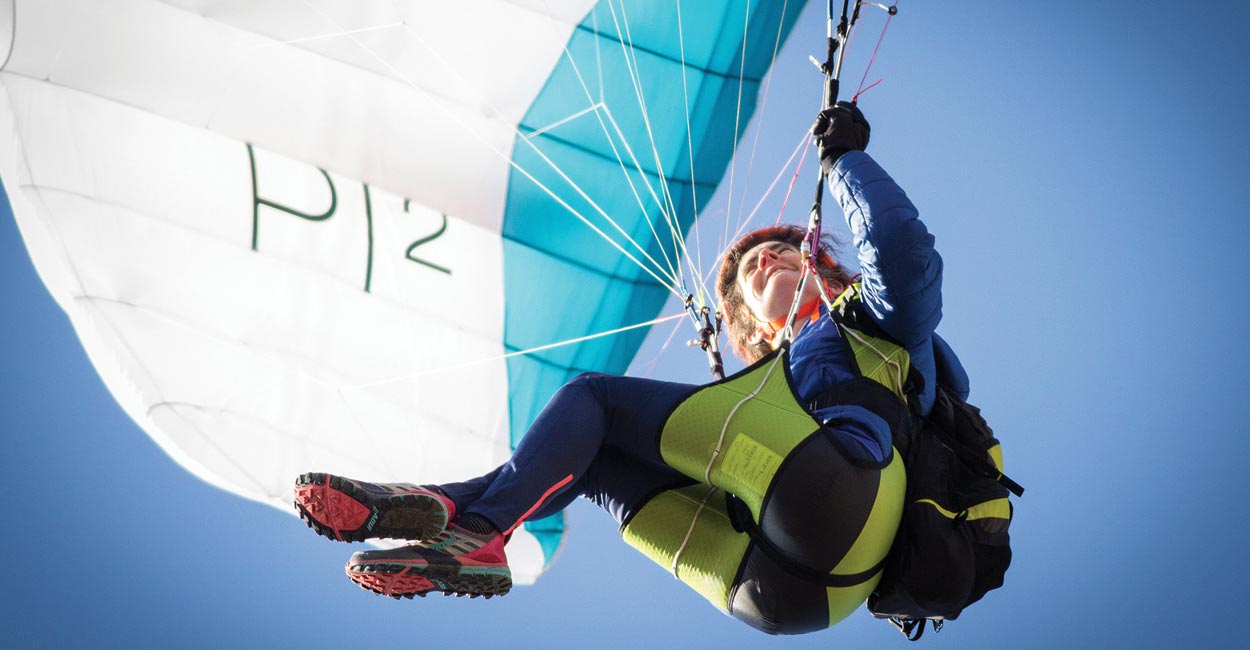
WE RUMBLED TO A STOP in a cloud of dust on Gourdon take-off, anxious to fly after a weather-induced lay-off, and took the last available parking space. It was busy, with lots of pilots feeling the urge to get airborne, but strangely there were very few wings in the air yet. Looked as if there was wind – the windsock was looking nice and solid – but damn, maybe too much.
Pilots were stood on launch in huddles, watching someone wrestle with a snaking wing and then popping off into the gusty flow. He was surviving. Looked OK, maybe a bit strong. While I was still deciding whether or not it was OK for me, Marcus came over and swapped his bag for mine; he reckoned it was the ideal day for him to take the 19m2 Pi 2 out. I hadn’t flown it yet but I didn’t argue.
While I lamented the recent conditions with the local pilots on launch, Marcus had a fun whizz about in the ridge lift, not getting super high but staying up and having fun. The 19m² wing is certified for both of us – Marcus with his pod harness and reserve was into the wing’s extended weight range (EN C) and edging into its “mini-wing” territory, where Advance say, “pilots should fly very actively with plenty of anticipation. Much higher airspeeds and higher sink rate in the turns require very good piloting”. Marcus said it was fun and responsive, but still efficient and not too radical. He plopped it down onto take-off and I unpacked my harness and attached the wing. I reckoned I could launch in this – my turn!
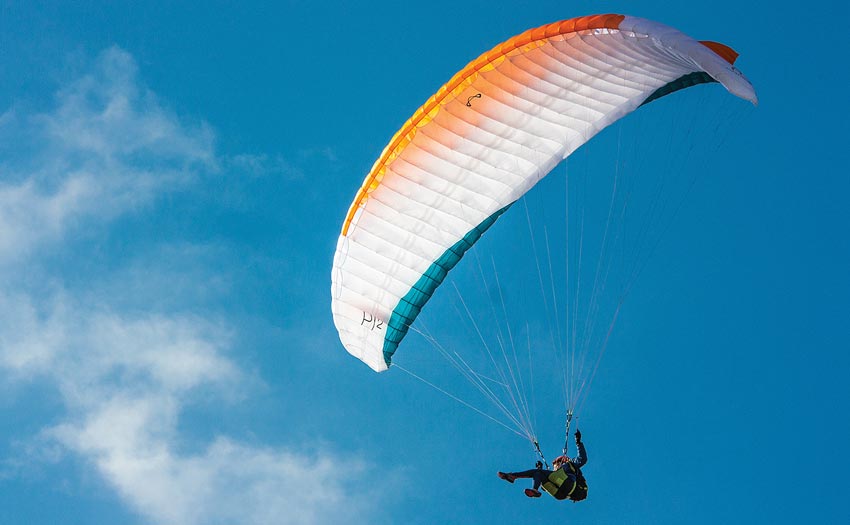
It can’t do that!
With my ‘proper’ harness and reserve I was on the border of Advance’s ‘thermik’ and ‘hike-and-fly’ weight ranges. 19m2 should be manageable for me, even in strongish winds, but I concentrated hard as I pulled firmly on the As and stepped underneath. There was no need to worry: the Pi 2 came up straight and true. A couple of steps and we were airborne. Our test wing had the lightweight riser set, with narrower webbing than the standard set and less substantial brake handles, although I found them comfortable. The standard riser set is 150g heavier, and gives you stiffer webbing risers with split-As for big ears, and more robust brake handles. Both sets are certified and have speedbars.
At first it was a bit of an up-and-down day; hugging the ridge I found lift and then sink, and I scooted around the bowl and along the ridge a bit, where I joined one of Ozone’s test pilots and we found a climb in front of take-off. He was testing their lightweight mountain wing too so we were on similar beasts. We circled around and climbed well above the upper launch. The Pi 2 and I instantly got on well. I felt completely comfortable – the brake pressure is light but positive, the reactions exactly as expected and she goes round easily.

I was smiling to myself as we’d got lucky – while most of the pilots were still on launch, we’d caught the best thermal of the day so far. Or so I thought. The test pilot glided out towards his colleagues who were circling high way out front on racy-looking blades, and I started to follow, climbing gently all the way.
Ah, so it wasn’t a lucky thermal. We were in some form of convergence and got an easy ride, way out towards the sea. My phone rang. I didn’t answer, but I knew it was Marcus – we had an appointment and I needed to get back. I wondered whether I would find any downwards-moving air, as it felt as if I was going to gently climb forever, but I headed back to launch to land by the car. Someone pointed at my wing and commented, “It’s not supposed to do that.”
Oh, but I think it is!
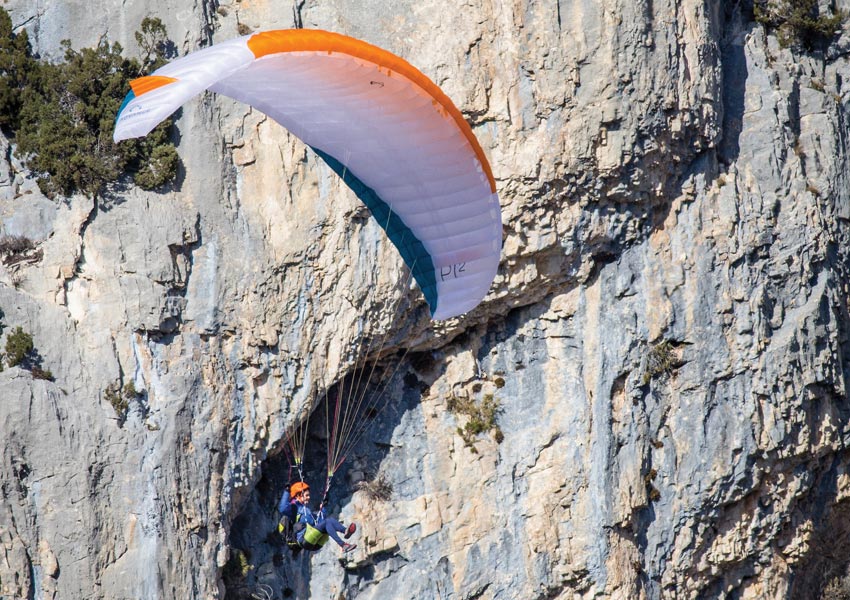
Going Strapless
After that first flight I did a lot of hike-and-flying with the Pi 2, switching to Advance’s Strapless harness for light weight and uber-packability. The 19m2 Pi 2 is just 2.5kg with the standard risers, and the Strapless is negligible really, at 190g. The Pi 2 comes in a Compressbag inner, which shapes it perfectly to fit the Pipack 2, which is a walking rucksack designed especially for it.
It’s lightweight, comfortable and practical, and very Advance: well thought-out and well finished, and just works. There’s a big stretchy pocket on the front that you could put a helmet in, though with the 19 I found a helmet easily fitted inside the bag.
Because it is well designed it holds its shape and is comfortable to carry, with a stretchy waist belt, padded shoulders and a breathable back pad. There are places to stow whatever you need to, including reachable stretchy and zippered pockets for phones and things. A breathable mesh panel on the side lets water vapour out in case you have to pack your wing away a bit damp.
I’d flown the Strapless harness before, so was prepared for its brevity. It folds into a flat disc in a little drawstring bag for transportation. Its lack of shoulder straps give it a nappy-ish look, sort of like a big pair of pants.
On launch, you attach it to the carry-handle of your rucksack (which doesn’t have to be the Pipack 2 – I also used it with my own running rucksack) with a little Velcro strap, then step into it. It feels most un-reassuring, and it’s only that little velcro strap that keeps it in place. The three loops – red on one side, blue on the other so you don’t get muddled – on the ends of the Dyneema which are the structure of the harness, clip into your main karabiners, and that’s it.

Take a deep breath, trust that Advance do things right and it is going to work, then go. In the air, the Strapless is a whole different beast. It’s at home, and it’s surprisingly comfortable. In fact, I think it could be the most comfortable hike-and-fly harness I’ve flown.
You slip back into it and feel very well enclosed. Your back and legs are well supported by the substantial pads, and I found no uncomfortable pressure points at all, even after more than an hour in the air you can still weight-shift in it.
I personally like its upright flying position – it’s designed like that in case you are carrying a sackful of hardware and ropes off a mountain, so your rucksack doesn’t drag you backwards.

In conclusion
I really fell in love with both wing and harness, which make an ideal hike-and-fly package – but they are more than that. With the Strapless and no reserve I’m in the middle of the ‘thermik’ zone, and it feels so good. It’s responsive and reassuring and go-anywhere. It was winter when we did the test, so I didn’t fly any rip-roaring thermal beasts, but we did a photo shoot one chilly morning which took well over an hour, and it was such an easy and fun wing to do it on. Go into the lift band and up it goes. It’s manoeuvrable and comfortable, and I would trust it for a potentially turbulent high-mountain launch. My first flight at Gourdon proved it can cope with wind, and if you are planning high-wind flights you could always choose a smaller size. It was with great reluctance that I posted this back to Advance.
UNDERSTANDING THE WING LOADING
The Pi concept is that depending on what weight you fly the wing at, you can use it for different things. If you fly it light, it’s an easily-accessible glider for anyone and everyone. If you fly it heavy, then the wing becomes an “action wing” and requires “very good piloting”. Advance has three divisions for the Pi 2: Thermal Range; Hike and Fly; and MiniWing.
Thermal Range: With up to 3.5 kg/m2 wing loading, Advance say the Pi 2 is “very easy to fly”. Sizes 23 and 27 are rated EN A in the Thermal Range. Beginners, weekend pilots, and occasional flyers will feel fine. The smaller size 19 requires good active piloting; the 16 does not have a Thermal Range.
Hike-and-fly: Wing loading 3.5 to 4.5 kg/m2. Here the wing is intended for pilots and hikers who hike up and fly down. The 23 and 27 require a “competent and safe active flying style” in this weight range. This requirement applies even more to the 16 and 19 because these smaller wings are more manoeuvrable.
MiniWing: Wing loading of 4.5 kg/m2 and up. Here the Pi 2 becomes an “actionwing”. Pilots should fly “very actively with plenty of anticipation”. The wing is loaded, and will have faster airspeed and higher sink-rate in the turns. Flying the wing in this range is for advanced pilots who are happy to fly fast and tight.
****
MANUFACTURER’S SPECIFICATIONS
What Advance say: “The new PI 2 is one of the lightest, smallest packed-volume serial wings on the market … one of the most versatile paragliders available today”.
Use: hike-and-fly, thermalling, mountain flying, mini-wing fun
Pilot level: Beginners to experts – depends on loading
Sizes (m²): 16, 19, 23, 27
Flat area (m²): 16, 19, 23, 27
Recommended take-off weight (kg): 50-90, 50-75, 65-95, 75-105
Extended take-off weight (kg): N/A, 75-95, 95-110, 105-120
Glider weight with standard risers (kg): 2.20, 2.50, 2.90, 3.25
Glider weight with lightweight risers (kg): 2.05, 2.35, 2.75, 3.10
Cells: 39
Flat aspect ratio: 4.5
Certification: C, B/C, A/B, A/B
Charlie flew the 19m² Pi 2 with a Swing Connect Reverse at 65kg all-up and a Strapless at 61kg all-up in the south of France
To stay up to date and read our reviews first, subscribe to Cross Country





